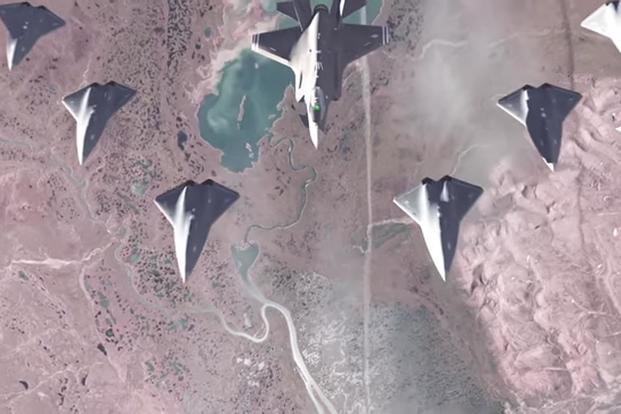The U.S. Air Force will pit a drone against a fighter jet in an aerial combat demonstration next year. It's just one example of how the service is gunning to change the character of warfare, top officials say.
Last week, Lt. Gen. Jack Shanahan, head of the Pentagon's Joint Artificial Intelligence Center, revealed that the Air Force Research Lab is working on an "autonomous system to go up against a human, manned system in some sort of air-to-air" test in July 2021. Speaking during a Mitchell Institute event, he said the test will be an indication of how the service's outlook is growing when it comes to the next dynamic battlefront.
Read Next: Trump Shuts Down Proposal to Rename Army Bases Honoring Confederate Fighters
"The drones we're exploring fit into the broader concept of, 'It's time to not talk about X-generation aircraft, it's time to talk about next generation air power,'" Dr. Will Roper, assistant secretary of the Air Force for acquisition, technology and logistics, said Tuesday when asked about how the test fits into the service's larger drone enterprise.
"The drones we're exploring are this 'next thing' that make a ton of sense to put on top of your stealth [fighter] advantage -- the ability to push something forward," he said during a video chat, also hosted by the Mitchell Institute.
The futuristic drone "can be a sensor for you, it can be a jammer for you, it can be a shooter for you," Roper said. "It's detecting for you ... and all the other things your imagination could dream up, that's what we're dreaming up."
That's especially true when it comes to leveraging artificial intelligence-driven drones to lead in the battlespace, he added. Roper has not been shy about using the Air Force's Skyborg project as an example of how AI can augment an F-35 Joint Strike Fighter or F-22 Raptor team sent out to conduct strikes.
"No one has flown with a digital pilot," he said of Skyborg, which seeks to pair AI with a human piloting a fighter jet -- training with its pilot, acting as a sidekick, rapidly thinking through problems and taking command if necessary.
Last year during the Paris Air Show, Roper said discussions were ongoing within the Air Force about the need for a proposed sixth-gen fighter concept, which could be the successor to F-22s and F-35s. But he also said the service is likely to choose something more elaborate.
"I think that's going to be a hallmark of sixth generation of air superiority," he said Tuesday of the drone-fighter pairing.
Skyborg could also fly with bombers and tankers "to provide extra defensive capability," Roper said. The Air Force launched an official solicitation for Skyborg last month.
Roper said that, regardless of the type of unmanned aircraft headed out to do the mission, artificial intelligence will undoubtedly have a role to play in gathering and quickly disseminating information.
For example, the replacement for the MQ-9 Reaper -- known as MQ-Next, aimed at having a more capable drone that can survive hostile environments -- should hone intelligence, surveillance and reconnaissance gathering by adopting algorithmic technologies from the get-go.
The service posted a request for information solicitation for MQ-Next last week.
"The way we can really drop the cost per hour of ISR is if algorithms are doing most of the triaging of the raw video, and only sending back to remote operators objects that are of interest that are [important] to look at," Roper said, adding that it would cut down the number of airmen needed to sift through the data -- something the Air Force has attempted to do for years.
Researchers will look to Skyborg for the MQ-Next program, he said. "That's what's exciting about it, is there are multiple variables at play here.
"The roots of the Air Force are all about breaking boundaries and doing new things," Roper said.
-- Oriana Pawlyk can be reached at oriana.pawlyk@military.com. Follow her on Twitter at @Oriana0214.
Related: Air Force Generals to Elon Musk: The Fighter Jet Era Isn't over Yet












